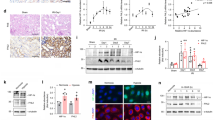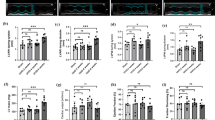Abstract
Urocortin-2 (UCN2) is cardioprotective in ischemia/reperfusion injury (I/R) through short-lived activation of ERK1/2. Key factors involved in I/R, e.g. apoptosis, mitochondrial damage, p38 kinase, and Bcl-2 family, have not been well-investigated in UCN2-induced cardioprotection. We assessed the role of p38-MAPK in anti-apoptotic Bcl-2 signaling and mitochondrial stabilization as a putative mechanisms in UCN2-induced cardioprotection. Isolated hearts from adult Sprague–Dawley rats and cultured H9c2 cells were subjected to I/R protocols with or without 10 nM UCN2 treatment. The effect of a specific p38 inhibitor SB202190 was tested in H9c2 cells. Cardiac function, LDH release, and mitochondrial membrane potential (MMP) were used to assess the degree of myocardial injury in hearts and H9c2 cells. Post-perfusion, hearts were collected for Western blot analyses or mitochondria/cytosol isolation to analyze p38 activation and Bcl-2 family members. UCN2 treatment improved rate-pressure product (58 ± 5 vs. 31 ± 4 % of Baseline; P < 0.05) and decreased LDH release (20 ± 9 vs. 90 ± 40 mU/ml LDH, P < 0.01) at the end of 60 min reperfusion. UCN2 reduced phospho-p38 levels and Bax activation. UCN2 increased the expression of Bcl-2 and inhibited the accumulation of p-Bim. With additional experiments, it was confirmed that UCN2 increases the phosphorylation of ERK1/2 in the early phase of UCN2 treatment and increases the overshot recovery of ERK1/2 phosphorylation during reperfusion. UCN2 and SB202190 partially prevented the loss of MMP induced by I/R. However, combined treatment with UCN2 and SB202190 did not provide additive benefit. UCN2 is cardioprotective in I/R in association with reduced phosphorylation of p38 together with the increased ERK1/2 activation and increased Bcl-2 family member pro-survival signaling. These changes may stabilize cardiac mitochondria, similar to p38 inhibitors, as part of a pro-survival mechanism during I/R.








Similar content being viewed by others
References
Fekete EM, Zorrilla EP (2007) Physiology, pharmacology, and therapeutic relevance of urocortins in mammals: ancient CRF paralogs. Front Neuroendocrinol 28:1–27
Barry SP, Lawrence KM, McCormick J, Soond SM, Hubank M, Eaton S, Sivarajah A, Scarabelli TM, Knight RA, Thiemermann C, Latchman DS, Townsend PA, Stephanou A (2010) New targets of urocortin-mediated cardioprotection. J Mol Endocrinol 45:69–85
Schulman D, Latchman DS, Yellon DM (2002) Urocortin protects the heart from reperfusion injury via upregulation of p42/p44 MAPK signaling pathway. Am J Physiol Heart Circ Physiol 283:H1481–H1488
Yuan Z, McCauley R, Chen-Scarabelli C, Abounit K, Stephanou A, Barry SP, Knight R, Saravolatz SF, Saravolatz LD, Ulgen BO, Scarabelli GM, Faggian G, Mazzucco A, Saravolatz L, Scarabelli TM (2010) Activation of Src protein tyrosine kinase plays an essential role in urocortin-mediated cardioprotection. Mol Cell Endocrinol 325:1–7
Patel K, Rademaker MT, Kirkpatrick CM, Charles CJ, Fisher S, Yandle TG, Richards AM (2012) Comparative pharmacokinetics and pharmacodynamics of urocortins 1, 2 and 3 in healthy sheep. Br J Pharmacol 166:1916–1925
Meili-Butz S, Buhler K, John D, Buser P, Vale WW, Peterson KL, Brink M, Dieterle T (2010) Acute effects of urocortin 2 on cardiac function and propensity for arrhythmias in an animal model of hypertension-induced left ventricular hypertrophy and heart failure. Eur J Heart Fail 12:797–804
Rademaker MT, Charles CJ, Nicholls MG, Richards AM (2008) Urocortin 2 combined with angiotensin-converting enzyme inhibition in experimental heart failure. Clin Sci (Lond) 114:635–642
Brar BK, Jonassen AK, Egorina EM, Chen A, Negro A, Perrin MH, Mjos OD, Latchman DS, Lee KF, Vale W (2004) Urocortin-II and urocortin-III are cardioprotective against ischemia reperfusion injury: an essential endogenous cardioprotective role for corticotropin releasing factor receptor type 2 in the murine heart. Endocrinology 145:24–35 discussion 21-3
Chanalaris A, Lawrence KM, Stephanou A, Knight RD, Hsu SY, Hsueh AJ, Latchman DS (2003) Protective effects of the urocortin homologues stresscopin (SCP) and stresscopin-related peptide (SRP) against hypoxia/reoxygenation injury in rat neonatal cardiomyocytes. J Mol Cell Cardiol 35:1295–1305
Denise Martin E, De Nicola GF, Marber MS (2012) New therapeutic targets in cardiology p38 alpha mitogen-activated protein kinase for ischemic heart disease. Circulation 126:357–368
Liu B, Jian Z, Li Q, Li K, Wang Z, Liu L, Tang L, Yi X, Wang H, Li C, Gao T (2012) Baicalein protects human melanocytes from H2O2-induced apoptosis via inhibiting mitochondria-dependent caspase activation and the p38 MAPK pathway. Free Radic Biol Med 53:183–193
Cai B, Chang SH, Becker EB, Bonni A, Xia Z (2006) p38 MAP kinase mediates apoptosis through phosphorylation of BimEL at Ser-65. J Biol Chem 281:25215–25222
Oh CK, Han BS, Choi WS, Youdim MB, Oh YJ (2011) Translocation and oligomerization of Bax is regulated independently by activation of p38 MAPK and caspase-2 during MN9D dopaminergic neurodegeneration. Apoptosis 16:1087–1100
Ma XL, Kumar S, Gao F, Louden CS, Lopez BL, Christopher TA, Wang C, Lee JC, Feuerstein GZ, Yue TL (1999) Inhibition of p38 mitogen-activated protein kinase decreases cardiomyocyte apoptosis and improves cardiac function after myocardial ischemia and reperfusion. Circulation 99:1685–1691
Brunelle JK, Ryan J, Yecies D, Opferman JT, Letai A (2009) MCL-1-dependent leukemia cells are more sensitive to chemotherapy than BCL-2-dependent counterparts. J Cell Biol 187:429–442
Borutaite V (2008) AMPK, MAPK and Bax in the heart: some questions answered. Biochem J 412:e15–e16
Narita M, Shimizu S, Ito T, Chittenden T, Lutz RJ, Matsuda H, Tsujimoto Y (1998) Bax interacts with the permeability transition pore to induce permeability transition and cytochrome c release in isolated mitochondria. Proc Natl Acad Sci U S A 95:14681–14686
Desagher S, Martinou JC (2000) Mitochondria as the central control point of apoptosis. Trends Cell Biol 10:369–377
Townsend PA, Davidson SM, Clarke SJ, Khaliulin I, Carroll CJ, Scarabelli TM, Knight RA, Stephanou A, Latchman DS, Halestrap AP (2007) Urocortin prevents mitochondrial permeability transition in response to reperfusion injury indirectly by reducing oxidative stress. Am J Physiol Heart Circ Physiol 293:H928–H938
Wang P, Fraser H, Lloyd SG, McVeigh JJ, Belardinelli L, Chatham JC (2007) A comparison between ranolazine and CVT-4325, a novel inhibitor of fatty acid oxidation, on cardiac metabolism and left ventricular function in rat isolated perfused heart during ischemia and reperfusion. J Pharmacol Exp Ther 321:213–220
Wang P, Zaragoza C, Holman W (2007) Sodium-hydrogen exchange inhibition and beta-blockade additively decrease infarct size. Ann Thorac Surg 83:1121–1127
Wang P, Tate JM, Lloyd SG (2008) Low carbohydrate diet decreases myocardial insulin signaling and increases susceptibility to myocardial ischemia. Life Sci 83:836–844
Van Kolen K, Dautzenberg FM, Verstraeten K, Royaux I, De Hoogt R, Gutknecht E, Peeters PJ (2010) Corticotropin releasing factor-induced ERK phosphorylation in AtT20 cells occurs via a cAMP-dependent mechanism requiring EPAC2. Neuropharmacology 58:135–144
Grammatopoulos DK, Randeva HS, Levine MA, Katsanou ES, Hillhouse EW (2000) Urocortin, but not corticotropin-releasing hormone (CRH), activates the mitogen-activated protein kinase signal transduction pathway in human pregnant myometrium: an effect mediated via R1alpha and R2beta CRH receptor subtypes and stimulation of Gq-proteins. Mol Endocrinol 14:2076–2091
Sanchez A, Tripathy D, Yin X, Desobry K, Martinez J, Riley J, Gay D, Luo J, Grammas P (2012) p38 MAPK: a mediator of hypoxia-induced cerebrovascular inflammation. J Alzheimers Dis 32:587–597
Chen CH, Chen SJ, Su CC, Yen CC, Tseng TJ, Jinn TR, Tang FC, Chen KL, Su YC (2013) Lee k I, Hung DZ and Huang CF: Chloroacetic acid induced neuronal cells death through oxidative stress-mediated p38-MAPK activation pathway regulated mitochondria-dependent apoptotic signals. Toxicology 303:72–82
Min H, Ghatnekar GS, Ghatnekar AV, You X, Bu M, Guo X, Bu S, Shen B, Huang Q (2012) 2-Methoxyestradiol induced Bax phosphorylation and apoptosis in human retinoblastoma cells via p38 MAPK activation. Mol Carcinog 51:576–585
Hsu YT, Wolter KG, Youle RJ (1997) Cytosol-to-membrane redistribution of Bax and Bcl-X(L) during apoptosis. Proc Natl Acad Sci U S A 94:3668–3672
Brunelle JK, Letai A (2009) Control of mitochondrial apoptosis by the Bcl-2 family. J Cell Sci 122:437–441
Berger A, Quast SA, Plotz M, Kammermeier A, Eberle J (2013) Sensitization of melanoma cells for TRAIL-induced apoptosis by BMS-345541 correlates with altered phosphorylation and activation of Bax. Cell Death Dis 4:e477
Harada H, Quearry B, Ruiz-Vela A, Korsmeyer SJ (2004) Survival factor-induced extracellular signal-regulated kinase phosphorylates BIM, inhibiting its association with BAX and proapoptotic activity. Proc Natl Acad Sci U S A 101:15313–15317
Meller R (2009) The role of the ubiquitin proteasome system in ischemia and ischemic tolerance. Neuroscientist 15:243–260
Kelly PN, Strasser A (2011) The role of Bcl-2 and its pro-survival relatives in tumourigenesis and cancer therapy. Cell Death Differ 18:1414–1424
Dedkova EN, Blatter LA (2012) Measuring mitochondrial function in intact cardiac myocytes. J Mol Cell Cardiol 52:48–61
Hernandez G, Lal H, Fidalgo M, Guerrero A, Zalvide J, Force T, Pombo CM (2011) A novel cardioprotective p38-MAPK/mTOR pathway. Exp Cell Res 317:2938–2949
Zhu H, Wang J, Li J, Li S (2011) Corticotropin-releasing factor family and its receptors: pro-inflammatory or anti-inflammatory targets in the periphery? Inflamm Res 60:715–721
Hwang SK, Kim HH (2011) The functions of mTOR in ischemic diseases. BMB Rep 44:506–511
Zhang R, Xu Y, Fu H, Wang J, Jin L, Li S (2009) Urocortin induced expression of COX-2 and ICAM-1 via corticotrophin-releasing factor type 2 receptor in rat aortic endothelial cells. Br J Pharmacol 158:819–829
Huang M, Kempuraj D, Papadopoulou N, Kourelis T, Donelan J, Manola A, Theoharides TC (2009) Urocortin induces interleukin-6 release from rat cardiomyocytes through p38 MAP kinase, ERK and NF-kappaB activation. J Mol Endocrinol 42:397–405
Tsatsanis C, Androulidaki A, Dermitzaki E, Gravanis A, Margioris AN (2007) Corticotropin releasing factor receptor 1 (CRF1) and CRF2 agonists exert an anti-inflammatory effect during the early phase of inflammation suppressing LPS-induced TNF-alpha release from macrophages via induction of COX-2 and PGE2. J Cell Physiol 210:774–783
Vogel C, Marcotte EM (2012) Insights into the regulation of protein abundance from proteomic and transcriptomic analyses. Nat Rev Genet 13:227–232
Acknowledgments
We appreciate the contribution of Dr. Paul Wolkowicz in the preparation of this manuscript. This work was supported by Cardiovascular Research Institute Start-up Fund (National University of Singapore, Singapore) and National Medical Research Council Center Grant (Ministry of Health, Singapore).
Conflict of interest
The authors declare that there are no conflicts of interest.
Author information
Authors and Affiliations
Corresponding author
Additional information
Xiu-Fang Gao and Yue Zhou have contributed equally to this work.
Rights and permissions
About this article
Cite this article
Gao, XF., Zhou, Y., Wang, DY. et al. Urocortin-2 suppression of p38-MAPK signaling as an additional mechanism for ischemic cardioprotection. Mol Cell Biochem 398, 135–146 (2015). https://doi.org/10.1007/s11010-014-2213-1
Received:
Accepted:
Published:
Issue Date:
DOI: https://doi.org/10.1007/s11010-014-2213-1




